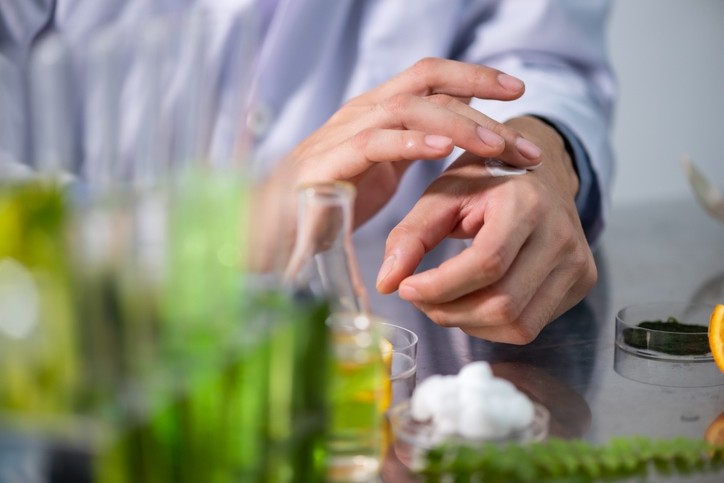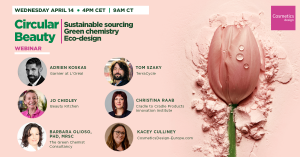L’Oréal kickstarts green sciences transition: ‘We are convinced of the essential need to change’

Last year, L’Oréal unveiled its For the Future 2030 sustainability plan that contained a raft of green goals, including transitioning to recycled or bio-based plastic packaging; ensuring all sites and centres were carbon neutral; and working towards making 95% of ingredients bio-based, derived from abundant minerals or circular. And this last goal required green sciences – methods and processes to reduce overall environmental impact that L’Oréal was acutely focused on in 2021, according to Nicolas Hieronimus, deputy CEO and soon-to-be chief of L’Oréal.
Green science shift – a ‘profound transformation’ in beauty R&D
Speaking at a dedicated Transparency Summit for invited press members earlier this month, Hieronimus said: “Green sciences will allow us to cultivate natural ingredients in a sustainable way – to extract the best of nature through high-tech processes. This virtuous approach will allow us to reach new levels of performance and discover new cosmetic benefits, without compromising on quality of safety.”
Barbara Lavernos, president of research, innovation and technology at L’Oréal, said sustainable innovation would be “revolutionised by green sciences” given the acceleration and possibilities offered by biotech, biofermentation and green chemistry, as well as new approaches to the circularity of resources.
“We open up this new chapter on research with green sciences relying on the tremendous progress and innovation brought about by natural sciences, agronomy, green chemistry or physical chemistry, and this is how we will revisit and reinvent our portfolio of raw materials and formulations. And integrating the principle of circularity will enable us to penetrate new areas of innovation,” Lavernos said.
Circular Beauty - Exclusive Expert Insight
Interested in the future of Circular Beauty? Want to know more about sustainable sourcing, green chemistry and eco-design?
Register now for our free webinar to hear from Garnier, TerraCycle, Beauty Kitchen, Cradle to Cradle and The Green Chemist Consultancy on challenges and opportunities ahead.
Laurent Gilbert, sustainable innovation director at L’Oréal, said the company’s research and innovation transition to green sciences was extremely timely and necessary.
“We are convinced of the essential need to change. We have this idea to make a cosmetic transition. That means a profound transformation in the way we will create and produce beauty products,” Gilbert said. “It’s important because our consumers are changing; they are aspiring to more ‘naturalness’, less chemistry, and products which are always safe and [perform better].”
Targeting a ‘really ambitious’ goal with green sciences
Across L’Oréal’s global portfolio today, Gilbert said 59% of ingredients were plant-based, 80% were biodegradable, 32% natural or naturally-derived and 29% created using green chemistry processes. Achieving the company goal for 95% of all ingredients to be bio-based, derived from abundant minerals or circular was therefore a “really ambitious” goal, he said, particularly given how complex certain ingredients like UV filters and hair dyes were to replace.
And green sciences, Gilbert said, would be applied to every part of the supply chain, not just formulation – from developing more sustainable crop systems for sourcing raw materials, prioritising biotech ingredients where possible, reducing waste during manufacturing and designing products with end-of-life in mind from the start, to reduce overall environmental impact. “This is not easy; it takes time,” he said.
Green sciences would firstly be applied to all new product development at L’Oréal, he said, and eventually used to transform existing products accordingly – “product renovation in a proactive way”.
But, as L’Oréal began its research and development transition into green sciences, how did it plan to communicate these, arguably complex, efforts to consumers?
Communicating ‘green sciences’ to consumers won’t be easy
Speaking to CosmeticsDesign-Europe, Gilbert said: “Indeed, these are complex processes and methods. Communicating them both authentically and simply is a challenge. But our goal is to humbly share our research and progress, to be as transparent as possible about our green sciences approaches.”
“Science has always been at the heart of our company and the fundamental pillar of our success with consumers. We want to share this science and to communicate transparently our approaches; being transparent about the composition of our products, the ingredients, their origin, their production conditions, so that consumers can make informed choices,” he said.

![Many beauty and personal care brands have already kickstarted important green initiatives and unveiled ambitious climate goals, and The European Green Deal must serve as an 'opportunity' for more action [Getty Images]](/var/wrbm_gb_food_pharma/storage/images/_aliases/wrbm_medium/publications/cosmetics/cosmeticsdesign-europe.com/article/2021/06/18/carbon-neutrality-2050-eu-goal-needs-green-beauty-push-says-globaldata/12578861-1-eng-GB/Carbon-neutrality-2050-EU-goal-needs-green-beauty-push-says-GlobalData.jpg)
![L'Oréal's Garnier and NYX Professional Make-Up products were now available for purchase in the UK directly via the TikTok app [Image: L'Oréal UK & Ireland]](/var/wrbm_gb_food_pharma/storage/images/_aliases/wrbm_medium/publications/cosmetics/cosmeticsdesign-europe.com/article/2021/06/17/l-oreal-uk-ireland-partners-with-tiktok-on-pilot-commerce-feature-with-garnier-and-nyx-professional-make-up/12574082-1-eng-GB/L-Oreal-UK-Ireland-partners-with-TikTok-on-pilot-commerce-feature-with-Garnier-and-NYX-Professional-Make-Up.jpg)
![Unilever will continue to upscale its 'refill on the go' trials where consumers can fill up stainless-steel bottles at refill stations but it will also trial in-aisle prefilled bottles to see if uptake is better [Image: Unilever]](/var/wrbm_gb_food_pharma/storage/images/_aliases/wrbm_medium/publications/cosmetics/cosmeticsdesign-europe.com/article/2021/06/16/unilever-expands-refill-and-reuse-trials-in-uk-in-partnership-with-beauty-kitchen-return.refill.repeat/12569802-1-eng-GB/Unilever-expands-refill-and-reuse-trials-in-UK-in-partnership-with-Beauty-Kitchen-Return.Refill.Repeat.jpg)
![Circulove has a range of four skin care products made using fermented ingredients and byproduct food-grade natural oils, packaged in airless bottles made from 30% of ocean plastic [Image: Circulove]](/var/wrbm_gb_food_pharma/storage/images/_aliases/wrbm_medium/publications/cosmetics/cosmeticsdesign-europe.com/article/2021/06/14/fermented-beauty-startup-circulove-talks-eu-and-us-expansion-circular-beauty-and-fermentation-power/12562668-1-eng-GB/Fermented-beauty-startup-Circulove-talks-EU-and-US-expansion-circular-beauty-and-fermentation-power.jpg)

















